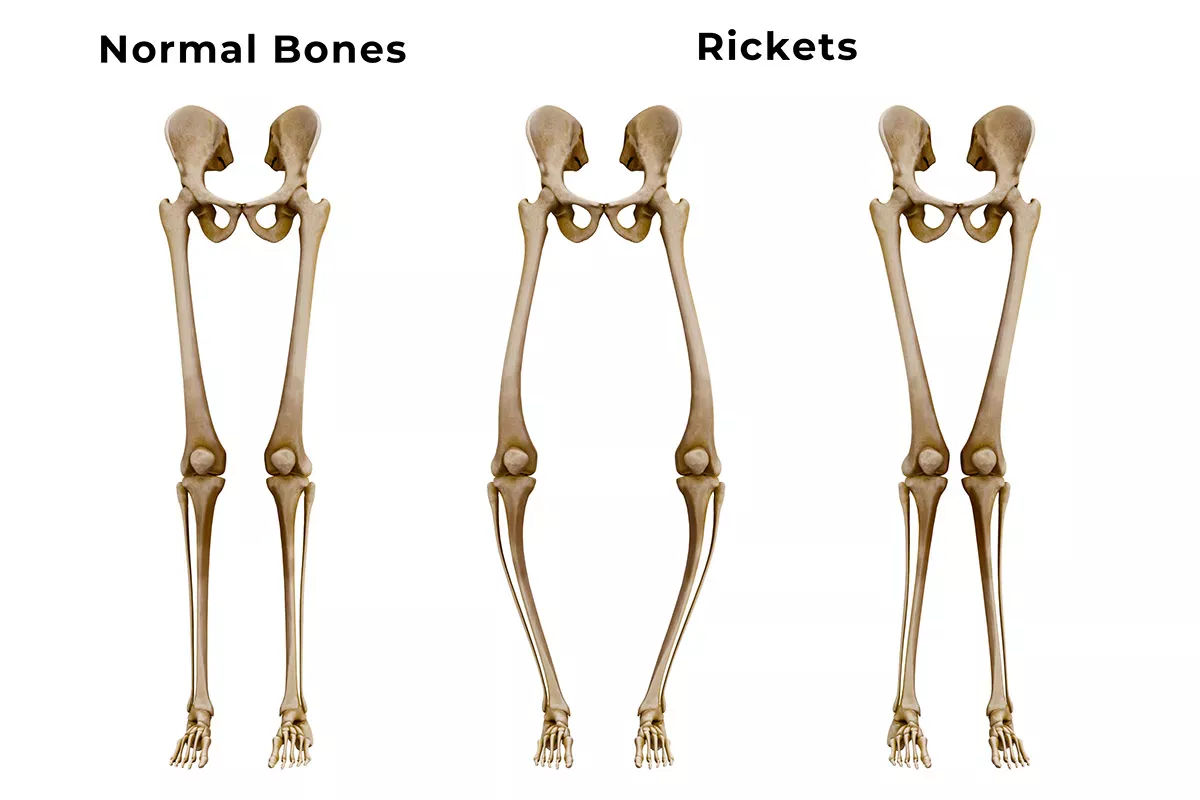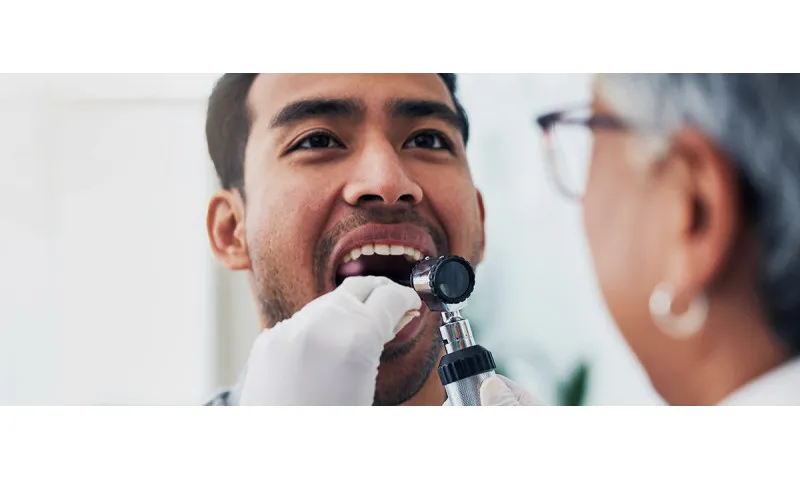Definition: What is rickets?
The term rickets is derived from the ancient Greek ῥάχις rháchis, which means back and spine. It is a metabolic disease that breaks out in childhood and leads to serious bone growth disorders if it is not treated.
The most common cause of rickets is a vitamin D deficiency, which occurs when children do not get enough sunlight. Malnutrition can also play a further, but rather minor, role in the development of rickets.
If there is no other vitamin D intake and the vitamin deficiency persists, this leads to insufficient mineralisation of the bones, i.e. decalcification. In simple terms, this causes the bones to soften and become bent. This mainly affects the spine, which is why the name of the disease "rickets" also refers to it. But leg deformities are also common.
Rickets causes countless symptoms, which we will explain to you in the course of this article. If the disease is not treated, it can also have late effects that cannot be reversed - for example, certain deformities in the skeleton or profound damage to the teeth. Muscles can also remain permanently weakened. As a consequence of these long-term effects, those affected can suffer from pain that they can no longer get rid of.
On the positive side, however, with appropriate treatment, leg deformities caused by rickets, for example, usually disappear. And another piece of good news: rickets is hardly an issue in children nowadays. This is due to systematic vitamin D prophylaxis, which starts soon after birth. We will also tell you more about this in the course of the article.
Good to know:
Bones can also demineralise and become soft in adults due to a vitamin D deficiency. However, this is not referred to as rickets, but as osteomalacia.
Excursus: How does vitamin D get into the body and how much do we need?
With the help of sunlight, or more precisely UV-B radiation, our body can produce up to 90 per cent of the required vitamin itself in the skin. Important to know: It must actually be sunlight that reaches our body. Unfortunately, a bright room and artificial light do not help us at all - and neither does a window into which the sun shines. This is because the UV-B components cannot penetrate the glass.
Diet is a somewhat subordinate factor. Its share in the formation of vitamin D is only 10 to 20 per cent. This is simply because only a few foods contain significant amounts of vitamin D. You can find out what these are in the section on preventing rickets.
Vitamin D has the following functions:
- promotes the absorption of calcium and the hardening of bones
- influences muscle strength
- regulates the calcium and phosphate metabolism
The German Nutrition Society (DGE) estimates an adequate intake of 20 micrograms of vitamin D per day for children, adolescents and adults. The majority of Germans do not have a vitamin D deficiency. However, almost 60 per cent of people do not reach the desirable blood concentration. This means that a large proportion of the population does not utilise the preventive potential of vitamin D for bone health and is not sufficiently supplied.
Nevertheless, you shouldn't just go out and buy your own vitamin D tablets from the chemist or drugstore. According to the Federal Institute for Risk Assessment, the risk of damage to health increases if we regularly take high-dose preparations without medical justification. For example, kidney stones form more frequently or kidney calcification occurs. Cases of acute kidney failure are also known.
Anyone who nevertheless takes the product without consulting a doctor should not exceed a daily dose of up to 20 micrograms (800 international units).
Good to know:
"International Units" (IU) is a unit of measurement for many medicinal substances used in medicine. This unit of measurement is based on internationally agreed standards and is defined by the World Health Organisation (WHO). With IU, the focus is not on the amount of substance, but on the pharmacological effect of the respective medication.
Causes and rickets
As briefly mentioned above, in most cases a vitamin D deficiency triggers rickets. However, a congenital disorder of vitamin D or phosphate metabolism may also be the cause. The cause is then insufficient formation of vitamin D3 in the liver or kidneys.
In very rare cases, rickets can also develop independently of vitamin D due to a form of phosphate diabetes - a congenital disorder that is passed on via inheritance. In this disease, those affected excrete too much phosphate in their urine. As phosphate, like vitamin D, is an integral part of the bone, this also leads to a softening of the bones if a corresponding deficiency occurs in the body.
Good to know:
Dark-skinned children have higher skin pigmentation and are less able to produce vitamin D through the skin than light-skinned children. They are therefore more susceptible to rickets.
Risk factors
You have already learnt that vitamin D deficiency is the greatest risk factor for the development of rickets. This deficiency can occur if:
- people are not in the sun enough - for example, if they are bedridden,
- malnutrition or malnutrition is present or
- The absorption or utilisation of vitamin D does not work well - for example in the case of chronic inflammatory bowel disease or coeliac disease.
Frequency of rickets
Due to vitamin D prophylaxis in infants and children, i.e. the addition of vitamin D, the disease does not play a major role in Germany. The incidence is only estimated, as rickets is not a notifiable disease. It is estimated that there are around 400 new cases per year in Germany. Dark-skinned children are most frequently affected worldwide.
Prognosis and chances of recovery
The disease is curable in both children and adults. The earlier it is diagnosed and treated, the better. This is because the consequences of rickets, namely bone deformities that have already occurred, can unfortunately not be reversed. It is therefore important to recognise the disease before it can affect the bones. You can find out more about prevention, diagnosis and treatment later in this article.
A look into history
Rickets used to be known as the English disease. The reason for this was that children had to work in mines in England during the Industrial Revolution and therefore hardly saw any daylight. The already low number of hours of sunshine due to the proximity to the Atlantic and the heavy air pollution caused by smog certainly also played a role. Thanks to the vitamin D prophylaxis mentioned above, the disease has declined worldwide.
Symptoms of rickets
If a child suffers from rickets, the first signs usually appear around the third month of life. The baby may then, for example, be unusually restless, jumpy and pale, have limited movement, flabby muscles or sweat at the back of the head. The urine may smell of ammonia. The first bone changes usually appear on the head. The reduction of the fontanel (gap between the bones of the skullcap in newborns) is delayed and remains open until the second year of life. The cranial sutures form slightly sunken furrows.
However, these symptoms are quite difficult for parents to interpret at such a young age. If you have the slightest doubt, you should consult a paediatrician.
Other possible complaints
Pain
Many children usually experience dull pain in the bones affected by rickets, making them very reluctant to walk or feel exhausted very quickly. The affected areas are often sensitive to pressure. Sometimes the gait of a child suffering from rickets is reminiscent of the waddling of a duck.
Deformations of the skeleton
- The ankles, wrists or knees can thicken, the legs can bend (to form so-called knock-knees or bow-legs)
- A "frog belly" can develop: This refers to a wide chest in the lower area due to a weak abdominal wall and lack of muscles. The result is a bulging abdomen.
- Formation of scoliosis: misalignment of the spine.
- Formation of a "funnel chest": The cartilage parts of the ribs are sunken in, as is the breastbone.
- The bones of the skull can become soft. In rare cases, a curvature of the spine may occur.
- Rachitic rosary: The cartilage-bone boundaries (growth plates) of the ribs and along the sternum swell, small lumps form along the ribs, which can be felt through the skin and are later also visible.
- Flattening of the occiput and protrusion of the forehead and parietal hump (also called "square skull").
Dental problems
Children with rickets often wait longer for their milk teeth to erupt. They have an increased risk of tooth decay and often suffer from enamel defects. You can find out everything you need to know about the impact of rickets on dental health in the next chapter.
Good to know:
Children who suffer from rickets are more susceptible to tooth decay. Their teeth need special protection. Read our article to find out how tooth decay develops and how best to prevent it:
Growth and development disorders
Sometimes children with rickets are smaller than other children their age. This is because the skeleton does not grow properly and therefore does not develop in line with their age.
Brittle bones
If rickets is very severe, it can lead to more frequent bone fractures in severe cases.
Muscle weakness
Children with rickets often suffer from muscle weakness and/or paroxysmal muscle cramps.
Susceptibility to disease
Affected children have a greater tendency to contract infectious diseases than other healthy children.
Symptoms in adults
Adults suffering from osteomalacia mainly complain of bone pain, which they describe as dull and long-lasting. As the symptoms are similar to those of rheumatism or osteoporosis, osteomalacia is sometimes not recognised quickly.
Diagnostics: How rickets is recognised
If rickets is suspected, the doctor will carry out various diagnostic procedures:
Clinical examination
The clinical examination means that the doctor asks about the patient's medical history (anamnesis). If rickets is suspected, there will certainly be questions about diet and time spent in the fresh air. The doctor will also assess the patient's overall physical impression.
Blood tests
Blood tests provide information about the levels of vitamin D, calcium, phosphate and parathyroid hormone in the blood. Blood tests can also be used to check liver and kidney function.
X-ray images
The doctor can recognise skeletal changes or deformities on the basis of X-ray images. The examination can be supplemented by bone density measurements.
Rickets and possible consequences for the teeth
If babies suffer from rickets, this also impairs their tooth development and tooth mineralisation. However, tooth mineralisation is particularly important: this refers to the storage of certain minerals in the enamel and dentin. If this process takes place as it should, it results in a solid enamel that protects our teeth from external influences; it is a hardening process, so to speak. A vitamin D deficiency and the resulting rickets disrupt this important process and can lead to defective enamel, which in turn is not resistant enough to protect children's teeth. For this reason, children with rickets are also more susceptible to tooth decay.
Good to know:
Milk teeth are much more susceptible than permanent teeth anyway. If there is a vitamin D deficiency or even rickets, the little teeth require even more intensive dental care. The baby toothbrush from Curaprox is ideal for this. The flexible and small brush head is equipped with an extra large number of fine bristles to gently but efficiently clean the entire baby mouth.
In addition, rickets can cause milk teeth to erupt very late. And, of course, the disease can also affect the jaw bones and soften them - just like all other bones. This can lead to deformations in the jaw, or malocclusions such as an open bite can develop.
Would you like to know what the malocclusion called "open bite" is all about? Then read all the important information in our article:
Treatment of rickets
If a child suffers from rickets, there are several treatment approaches according to the relevant guideline, which we would like to present to you here. Paediatricians, paediatric endocrinologists and diabetologists decide which treatment is recommended for each individual case. We present the various methods here:
Causal therapy
Causal therapy involves treating or eliminating the cause that triggered the rickets. As vitamin D deficiency is present in most cases, the administration of this vitamin is therefore the focus of treatment. According to the guideline, children up to the age of 12 months receive 2000 IU (international units) of vitamin D3 daily and an additional dose of calcium for a period of 12 weeks. After that, the dosage is reduced: Affected children then receive 500 IU of vitamin D3 per day - until the end of their first year of life.
From the age of two, children up to the age of 12 receive 3000 to 6000 IU of vitamin D3 plus calcium (at least 500 milligrams per day) for a period of 12 weeks.
If the diagnosis of "rickets" is only made from the age of 13, the affected children are given 6000 IU of vitamin D3 and between 500 and 1000 milligrams of calcium per day. After three to four weeks, a laboratory check should be carried out to adjust the dose if necessary.
Symptomatic therapy
Symptomatic therapy is not about treating the underlying causes of rickets, but rather its symptoms. For example, so-called hypocalcaemic tetany - neuromuscular hyperexcitability - can occur as a result of rickets. Its symptoms can include sensory disturbances in the limbs, heart problems and muscle cramps that occur in fits and starts. To treat these symptoms, the doctor administers a calcium gluconate solution intravenously according to the guidelines. This should then be administered orally without delay.
Interventional therapy
The aim of interventional therapy is to carry out targeted interventions in order to positively influence the course of the disease. In the guidelines, interventional therapy refers to the administration of calcium, which supplements the administration of high doses of vitamin D. If this is not observed, there is a risk of a so-called hypocalcaemic seizure. If this is not observed, there is a risk of a so-called hypocalcaemic seizure - a seizure that can occur due to low blood calcium levels.
Corrective operations on possible leg axis misalignments, which can be caused by rickets, are generally not necessary according to the guidelines. However, it is emphasised that it may well take two to three years for the leg axis to straighten out thanks to calcium and vitamin D supplementation.
Preventing rickets: tips for sufficient vitamin D intake
As you now know, it is crucial to avoid a vitamin D deficiency in the body. That way, rickets doesn't stand a chance. This is what the dosage recommendations say. However, as they vary somewhat, please be sure to discuss this with your paediatrician.
Babies / Infants
Babies and children have an increased need for vitamin D in their first 12 months of life. They need it for healthy bone formation. The German Society for Paediatrics and Adolescent Medicine (DGKJ) recommends the daily administration of a vitamin D tablet of 10 to 12.5 µg; this corresponds to 400 to 500 IU (International Units) from the end of the first week of life until the end of the first year of life. Parents can continue this preventive measure during the winter months in the second year of their child's life. Vitamin D is now also available as an oral spray or oil. In this form, vitamin D is easier to administer to children and can even be better absorbed by the body.
After the age of two, additional administration as a preventive measure is generally no longer necessary. However, it is advisable to discuss vitamin D intake with your paediatrician.
Adults
As you have already learnt, adults are not diagnosed with rickets, but with osteomalacia. For you, too, the mainstay of treatment is the administration of vitamin D3 and calcium. It is best to discuss further treatment recommendations with your doctor.
This applies equally to adults and children: rickets can usually be avoided by spending enough time in the fresh air and eating a good diet.
From March to October, for example, it is recommended to keep your face, hands and arms uncovered in the sun for short periods without sun protection. Very important: When staying in the sun for longer periods of time, make sure you use sun protection to avoid burns.
As far as nutrition is concerned, you can make sure that you and your child eat foods that are rich in vitamin D and calcium. These include, for example:
- Oily fish
- Cereal products
- Oat flakes
- Eggs
- Green leafy vegetables
- Almonds
- Dairy products
From March to October, for example, it is recommended to keep your face, hands and arms uncovered in the sun for short periods without sun protection. Very important: When staying in the sun for longer periods of time, make sure you use sun protection to avoid burns.
As far as nutrition is concerned, you can make sure that you and your child eat foods that are rich in vitamin D and calcium. These include, for example:
- Oily fish
- Cereal products
- Oat flakes
- Eggs
- Green leafy vegetables
- Almonds
- Dairy products
Sources:
AWMF Online: S1 guideline 174-007: Vitamin D deficiency rickets.
Federal Institute for Risk Assessment: Selected questions and answers on vitamin D.
Deutsche Apotheker Zeitung: Vitamin D for infants and children - when and how much?
Deutsches Ärzteblatt: Climate phenomenon (not climate change) explains increase in rickets in England and: Unauthorised vitamin D intake in small doses at most.
Deximed GP knowledge online: Rickets.
DocMedicus: Rickets.
Herold, Gerd und Mitarbeiter: Innere Medizin - eine vorlesungsorientierte Darstellung 2005.
Paediatricians on the net: Vitamin D deficiency/ rickets prophylaxis.
Paediatric and adolescent practice Dr Birgit Indlekofer: Rickets prophylaxis.
Kliniken der Stadt Köln gGmbH: Patient information on funnel chest.
LeadingMedicineGuide: Osteomalacia: Find information and a doctor.
Lecturio: Rickets.
Lubliner, Andrea: Rickets: Causes and therapy, on: Onmeda.de.
OptiDent GmbH: Mineralisation teeth dentistry.
Phosphatdiabetes e.V.: What is phosphate diabetes?
Robert Koch Institute: What consequences can a vitamin D deficiency have?
Dresden Municipal Hospital: Diagnostics.
Quintessence Publishing Germany: The rachitic tooth: The use of radiographs for screening.
Wissen.de: Tetany.
All websites open for the last time on 18.01.2024
 Swiss premium oral care
Swiss premium oral care








